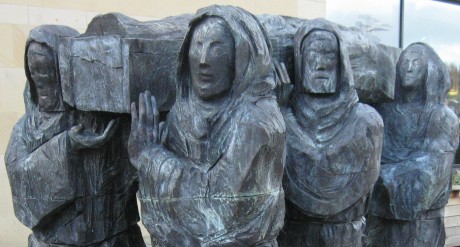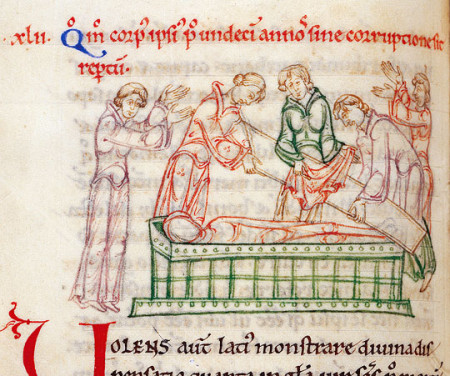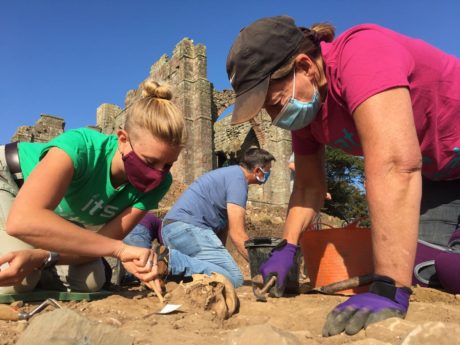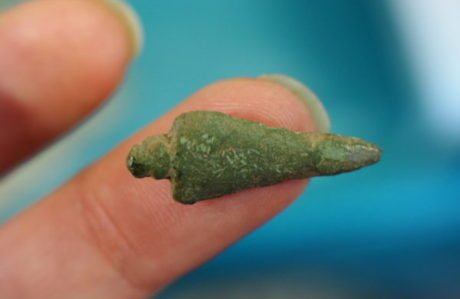
If there was an award given for saints who travelled the most after death, then Cuthbert would certainly be a worthy contender…
Saint Cuthbert was one of Lindisfarne’s most popular characters. He travelled a great deal during life, and even more so after death. His journey started in AD875, when the increasing intensity of Viking raids became too much for Lindisfarne’s monks, and they decided to flee. When they did, they took St Cuthbert’s remains with them. But they didn’t just go somewhere – they stayed on the road, moving from place to place for over a century, and Cuthbert stayed with them, until they finally settled down in Durham one hundred years later.
So who was St Cuthbert? And why did the monks of Lindisfarne deem him so important that they carried his remains with them on this epic journey?
The Life of St Cuthbert
We know a lot about Cuthbert through the writings of the Venerable Bede (AD672 – AD735), a prominent Anglo-Saxon scholar, who wrote two detailed records of his life (one in poetry and one in prose). Cuthbert was formally a monk, and later prior, of Melrose Abbey, who had come to Lindisfarne after a significant reshuffle in Northumbrian church doctrine (see: Synod of Whitby). This saw the church move away from Irish traditions to embrace those of Roman Christianity.
During his time at Lindisfarne, Cuthbert became famous for his commitment and devotion toward the church, and his gift for spiritual healing – the gift that would later form the foundation of his cult. After some time spent in the spotlight, Cuthbert desired a quieter life and was granted leave to become a hermit, retiring to a small islet adjoining Lindisfarne, now known as St Cuthbert’s Isle. Even then, Cuthbert received very little peace, as pilgrims continued to visit the islet to beseech him for his healing powers.
In fact, he was so popular, that his followers called him out of retirement. He was – reluctantly – made bishop of Lindisfarne. Having briefly re-entered society, Cuthbert made another break for it and isolated himself in a hermitage on the island of Inner Farne, until he died in AD687.
Sainthood
His story doesn’t end there though. Cuthbert was soon to become one of the most important English saints, though his saintly status wasn’t established until eleven years after his burial. In AD698, the monks exhumed his body and to their surprise found it hadn’t decayed; even going so far as to describe him as ‘as flexible as a living man’.
This miracle was later witnessed on many occasions and was deemed to signify his great holiness and worthiness to become a saint. The priory at Lindisfarne soon became a destination for pilgrims from all over Europe, and the cult of St Cuthbert was born. The journey to Lindisfarne is still an active pilgrim trail today, with many choosing to walk the awe inspiring ‘Pilgrim’s Way’ rather than drive the modern route to the island.
The Journey of St Cuthbert (Deceased)
Sadly, for St Cuthbert even in death his peace was short-lived. Nearly two centuries after his death, in AD875 Cuthbert was exhumed again; the threat from the Viking raids had grown too great and Lindisfarne’s monks had decided to flee. Of course, they couldn’t leave him behind, so with them they took his valuable remains and the precious Lindisfarne Gospels (the beautiful book which was probably crafted as part of the process of building the cult of Cuthbert). The monks carried his body for seven years until their lead persecutor, the Viking leader Halfden, died, allowing them to settle at Chester-le-Street. But not for long…
A century later renewed Viking raids meant that Cuthbert and the monks were on the move again, this time seeking refuge in Ripon before finally settling in Durham, where St Cuthbert’s remains still reside within the cathedral.
Cuthbert puts his foot down
According to legend, the decision to settle in Durham was taken by St Cuthbert himself, who is said to have made his coffin un-moveable before appearing in a vision to the monk’s leader, Bishop Aldhun, and demanding to be taken to Durham. The cathedral was later built around his remains.
St Cuthbert’s shrine at Durham still endures as a popular destination for pilgrims; the values of humility, simplicity, tolerance (as well as patience!) that he embodied ensure that he continues to be treated with reverence by modern Christians today.



